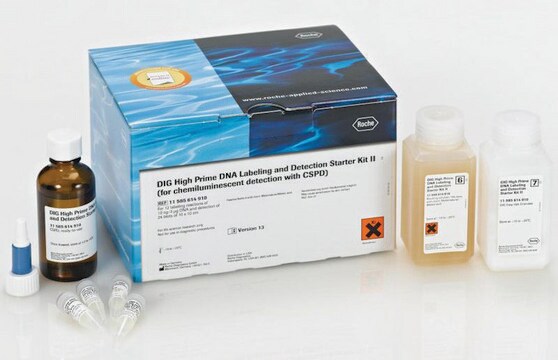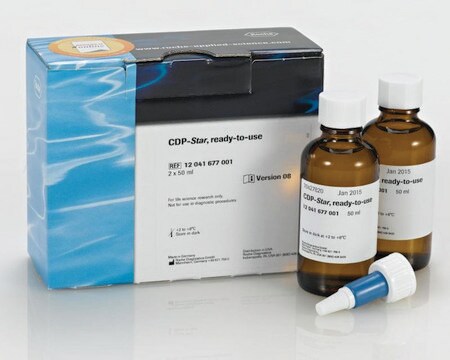Key Documents
11585762001
Roche
DIG Wash and Block Buffer Set
storage temp.:2-8°C
Synonim(y):
wash and block buffer set, dig
About This Item
Polecane produkty
Poziom jakości
producent / nazwa handlowa
Roche
charakterystyka ekologicznej alternatywy
Designing Safer Chemicals
Learn more about the Principles of Green Chemistry.
sustainability
Greener Alternative Product
kategoria ekologicznej alternatywy
, Aligned
temp. przechowywania
2-8°C
Opis ogólny
Washing, blocking and detection buffers (10x concentrated) for the immunological detection of DIG - (digoxigenin-)labeled probes.
Zastosowanie
Opakowanie
Jakość
Uwaga dotycząca przygotowania
For one labeling reaction pipette:
1 μl dATP, (vial 2)
1 μl dGTP, (vial 4)
1 μl dTTP, (vial 5)
to a reaction vial.
Note: If the same type of labeled deoxyribonucleoside-triphosphate is used repeatedly, we recommend the preparation of a mixture of equal parts of the other three deoxyribonucleoside-triphosphates for convenience.
Storage conditions (working solution):
- After the first usage, the buffers should be stored further at 2 to 8 °C. We recommend to store the concentrated Blocking solution in aliquots at -15 to -25 °C.
- When Autoclaved: Stock solution can be stored for several days to a week either unopened at RT or at 2 to 8 °C after opening. Alternatively, it can be stored in aliquots at -15 to -25 °C for up to 6 months.
Inne uwagi
Tylko elementy zestawu
- Washing Buffer 10x concentrated
- Maleic acid Buffer 10x concentrated
- Blocking Solution 10x concentrated
- Detection Buffer 10x concentrated
Hasło ostrzegawcze
Warning
Zwroty wskazujące rodzaj zagrożenia
Zwroty wskazujące środki ostrożności
Klasyfikacja zagrożeń
Eye Irrit. 2 - Skin Irrit. 2
Kod klasy składowania
12 - Non Combustible Liquids
Klasa zagrożenia wodnego (WGK)
WGK 3
Temperatura zapłonu (°F)
Not applicabledoes not flash
Temperatura zapłonu (°C)
Not applicabledoes not flash
Certyfikaty analizy (CoA)
Poszukaj Certyfikaty analizy (CoA), wpisując numer partii/serii produktów. Numery serii i partii można znaleźć na etykiecie produktu po słowach „seria” lub „partia”.
Masz już ten produkt?
Dokumenty związane z niedawno zakupionymi produktami zostały zamieszczone w Bibliotece dokumentów.
Klienci oglądali również te produkty
Nasz zespół naukowców ma doświadczenie we wszystkich obszarach badań, w tym w naukach przyrodniczych, materiałoznawstwie, syntezie chemicznej, chromatografii, analityce i wielu innych dziedzinach.
Skontaktuj się z zespołem ds. pomocy technicznej









![CDP-Star® Disodium 2-chloro-5-(4-methoxyspiro {1,2-dioxetane-3,2′-(5′-chloro)tricyclo[3.3.1.13,7 ]decan}-4-yl)-1-phenyl phosphate](/deepweb/assets/sigmaaldrich/product/structures/224/846/d08963f5-c8ba-42e6-b4f7-9ee7fd76d809/640/d08963f5-c8ba-42e6-b4f7-9ee7fd76d809.png)